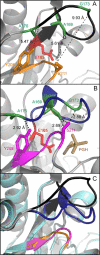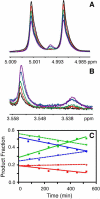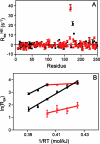Role of loop-loop interactions in coordinating motions and enzymatic function in triosephosphate isomerase
- PMID: 19348462
- PMCID: PMC2713366
- DOI: 10.1021/bi9002887
Role of loop-loop interactions in coordinating motions and enzymatic function in triosephosphate isomerase
Abstract
The enzyme triosephosphate isomerase (TIM) has been used as a model system for understanding the relationship between protein sequence, structure, and biological function. The sequence of the active site loop (loop 6) in TIM is directly correlated with a conserved motif in loop 7. Replacement of loop 7 of chicken TIM with the corresponding loop 7 sequence from an archaeal homologue caused a 10(2)-fold loss in enzymatic activity, a decrease in substrate binding affinity, and a decrease in thermal stability. Isotope exchange studies performed by one-dimensional (1)H NMR showed that the substrate-derived proton in the enzyme is more susceptible to solvent exchange for DHAP formation in the loop 7 mutant than for WT TIM. TROSY-Hahn Echo and TROSY-selected R(1rho) experiments indicate that upon mutation of loop 7, the chemical exchange rate for active site loop motion is nearly doubled and that the coordinated motion of loop 6 is reduced relative to that of the WT. Temperature dependent NMR experiments show differing activation energies for the N- and C-terminal hinges in this mutant enzyme. Together, these data suggest that interactions between loop 6 and loop 7 are necessary to provide the proper chemical context for the enzymatic reaction to occur and that the interactions play a significant role in modulating the chemical dynamics near the active site.
Figures







Similar articles
-
Dynamic requirements for a functional protein hinge.J Mol Biol. 2007 Apr 20;368(1):131-49. doi: 10.1016/j.jmb.2007.01.074. Epub 2007 Feb 3. J Mol Biol. 2007. PMID: 17336327 Free PMC article.
-
Solution NMR and computer simulation studies of active site loop motion in triosephosphate isomerase.Biochemistry. 2006 Sep 12;45(36):10787-94. doi: 10.1021/bi060764c. Biochemistry. 2006. PMID: 16953564
-
Value of a hydrogen bond in triosephosphate isomerase loop motion.Biochemistry. 2007 May 22;46(20):6001-10. doi: 10.1021/bi700344v. Epub 2007 Apr 25. Biochemistry. 2007. PMID: 17455914
-
Characterization of enzyme motions by solution NMR relaxation dispersion.Acc Chem Res. 2008 Feb;41(2):214-21. doi: 10.1021/ar700132n. Epub 2008 Feb 19. Acc Chem Res. 2008. PMID: 18281945 Review.
-
Triosephosphate isomerase: a highly evolved biocatalyst.Cell Mol Life Sci. 2010 Dec;67(23):3961-82. doi: 10.1007/s00018-010-0473-9. Epub 2010 Aug 7. Cell Mol Life Sci. 2010. PMID: 20694739 Free PMC article. Review.
Cited by
-
Rate-limiting domain and loop motions in arginine kinase.Biochemistry. 2011 May 17;50(19):4011-8. doi: 10.1021/bi101664u. Epub 2011 Apr 22. Biochemistry. 2011. PMID: 21425868 Free PMC article.
-
Dynamozones are the most obvious sign of the evolution of conformational dynamics in HIV-1 protease.Sci Rep. 2023 Aug 30;13(1):14179. doi: 10.1038/s41598-023-40818-x. Sci Rep. 2023. PMID: 37648682 Free PMC article.
-
Ribosome External Electric Field Regulates Metabolic Enzyme Activity: The RAMBO Effect.J Phys Chem B. 2024 Jul 25;128(29):7002-7021. doi: 10.1021/acs.jpcb.4c00628. Epub 2024 Jul 16. J Phys Chem B. 2024. PMID: 39012038 Free PMC article.
-
Probing local structural fluctuations in myoglobin by size-dependent thiol-disulfide exchange.Protein Sci. 2010 Aug;19(8):1587-94. doi: 10.1002/pro.440. Protein Sci. 2010. PMID: 20572017 Free PMC article.
-
A role for flexible loops in enzyme catalysis.Curr Opin Struct Biol. 2010 Dec;20(6):702-10. doi: 10.1016/j.sbi.2010.09.005. Epub 2010 Oct 13. Curr Opin Struct Biol. 2010. PMID: 20951028 Free PMC article. Review.
References
-
- Hedstrom L, Szilagyi L, Rutter WJ. Converting trypsin to chymotrypsin: the role of surface loops. Science. 1992;255:1249–1253. - PubMed
-
- Peng T, Zintsmaster JS, Namanja AT, Peng JW. Sequence-specific dynamics modulate recognition specificity in WW domains. Nat Struct Mol Biol. 2007;14:325–331. - PubMed
-
- Venkitakrishnan RP, Zaborowski E, McElheny D, Benkovic SJ, Dyson HJ, Wright PE. Conformational changes in the active site loops of dihydrofolate reductase during the catalytic cycle. Biochemistry. 2004;43:16046–16055. - PubMed
Publication types
MeSH terms
Substances
Grants and funding
LinkOut - more resources
Full Text Sources

